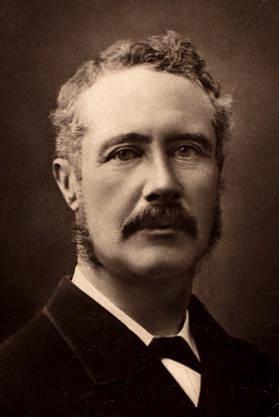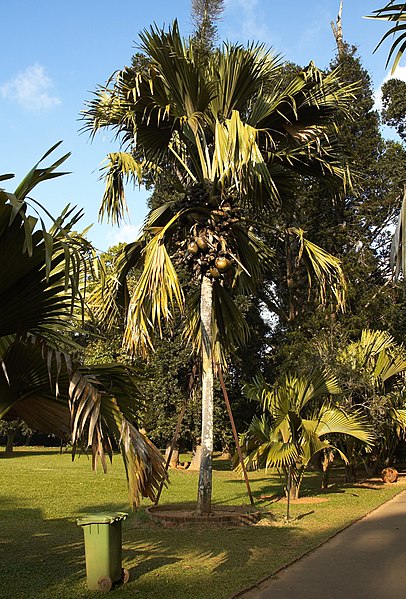General Gordon:
"Some had sought for the seat of Eden by geography, and had failed;
some had interpreted by allegory; some, alas! had disbelieved it altogether;
but he would seek it by the plainest of all evidence,
the evidence of the Maker himself, as embodied in His work."
"Some had sought for the seat of Eden by geography, and had failed;
some had interpreted by allegory; some, alas! had disbelieved it altogether;
but he would seek it by the plainest of all evidence,
the evidence of the Maker himself, as embodied in His work."
General Gordon was heralded in Britain after his death as a sort of Victorian saint, both for his heroic, unsuccessful defense of Khartoum from the "barbarian horde" of the Mahdist forces and his perceived Christian virtue. He was a short man, even in those nutrition-deficient days, standing 5' 5", and never married, despite his sturdy build and admirable mustache. Gordon had become a fundamentalist Christian in 1853. He traveled in Palestine in 1882 and 1883, seeing the sundry holy sites there and afterward writing up an account of his journey, Reflections in Palestine.
Lytton Strachey, in his classic multi-biography Eminent Victorians, opens his profile of Gordon thus:
"During the year 1883 a solitary English gentleman was to be seen, wandering, with a thick book [the Bible] under his arm, in the neighbourhood of Jerusalem... To the friendly inquirer, he would explain, in a low, soft, and very distinct voice, that he was engaged in elucidating four questions—the site of the crucifixion, the line of division between the tribes of Benjamin and Judah, the identification of Gibeon, and the position of the Garden of Eden. He was also, he would add, most anxious to discover the spot where the Ark first touched ground, after the subsidence of the Flood."†
Gordon in personally-designed "Neo-Adamite" garb.
Gordon had, it must be said, several beliefs that might have been unique among Victorian Evangelicals. He believed in reincarnation. The Earth, he thought, was enclosed in a sphere, with heaven outside of this, and God's throne directly above the Temple in Jerusalem. Pitcairn Island, on the opposite side of the world from Jerusalem, was the seat of the Devil.‡ A real English original, that Gordon!
The Seychelles - Cradle of Humanity or Great Cruise Destination?
Praslin "Garden of Eden" Island in the Seychelles
While stationed as a Royal Engineer in the British Indian Ocean colony of Mauritius Gordon traveled the nearby Seychelles archipelago (then part of British Mauritius). Visiting the small island of Praslin, Gordon, Biblical gumshoe that he was, became fixed upon the unique flora and fauna of the island. In particular, he was fascinated by the Coco de Mer palm tree, which only grew on Praslin and one other island.
In a letter to a Christian missionary, later published, Gordon writes, "in Praslin, near Seychelles, and only there in the whole world, is a magnificent tree, curious beyond description, called the Prince of the Vegetable kingdom." After a deep investigation, Gordon decided that the Coco de Mer (Lodoicea maldivica) was the tree of the knowledge of good and evil from the Garden of Eden. The palm's unique fruit, the largest plant seed in the world, which takes seven years to mature, he concluded, was the forbidden fruit with which the Serpent tempted Adam and Eve. This might have had something to do with its similarity in shape to a (female) buttocks.§
"Through 300 years one wild superstition after another has twined itself about this fruit, and now, towards the end of the nineteenth century on the very summit of progress and civilisation, there comes a plain God-fearing soldier, and sees in it the unconscious instrument of man's first disobedience." (GC&HN)
Coco de Mer, with 'rubbish bin'.
Gordon's Garden: The Seychelles are on the lower-right. (From The Strand Magazine.**)
Gordon's topographical map of his Seychellian Eden - the top is an overhead shot, the bottom a cross-section.
Lucas Cranach the Elder's 16th-century rendition of the Seychelles countryside.
Gordon's idea had some evidential difficulties to overcome. Seychelles was no where near two of the rivers mentioned in Genesis, the Tigris and Eurphrates, which are in the Middle East. The Garden was never referred to as an island, and Adam and Eve's boat journey from Eden to the outside world went unrecorded.
Critical consensus was no kinder. The editor of the highly respected trade periodical Gardeners' Chronicle and New Horticulturist in 1888 called Gordon's theory an "almost grotesquely absurd conclusion," at least in botanical terms. In 1892, the editor of the Journal of the Transactions of the Victoria Institute named it "the latest and most quaint theory regarding the site of the Garden of Eden." I am sad to say that Gordon's pioneering archaelogical and geological research in the area was never followed up by succeeding generations. If, Dear Reader, you are an archaeology graduate student looking for some doctoral field work, the opportunity is as a ripe fruit for the taking!
Gordon defending himself against a horde of botanical and theological detractors.
Yet it seems Gordon went to his hallowed grave with the belief that he had discovered the Garden of Eden. He was a man of convictions, nineteenth-century-style, for good or ill. As a final note, it must be said that General Gordon was only one of many amateur Edenologists during the Victorian age. A recent book by Brook Wilensky-Lanford, Paradise Lust: Searching for the Garden of Eden, profiles many of the eccentric (and semi-plausable) theories about the location of the Garden.†† (She doesn't discuss Gordon, though!) So, if you'd like to learn more, check out her tome, or you can wait for the release of the sequel I am writing, Paradise Refrained: The Historical Search for Terrestrial and Subterranean Entrances to Hell, the Underworld, and the Hollow Earth.‡‡
__________________________________________________
* Our man Gordon was no relation to the Romantic poet and fellow English eccentric George Gordon, Lord Byron.
† This location was later discovered by Field Marshal Horatio Herbert Kitchener, 1st Earl Kitchener (1850-1916) in British Iraq.
‡ Perhaps the fallen nineteenth-century "colonists" of Pitcairn, mutinous progeny of the eighteenth-century HMS Bounty rebels, helped to inspire Gordon's theory.
§ Also the flower looks like a penis (human)!
** Victorian institution famous for publishing the Sherlock Holmes stories, including "The Adventure of the Garden of Eden."
†† This is NOT where I got the idea for this Cabinet post!
‡‡ Self-published, forthcoming.







